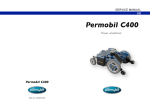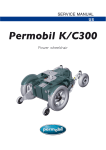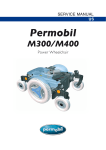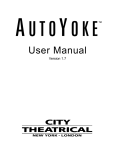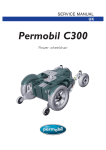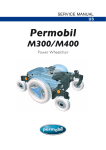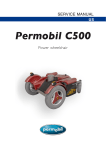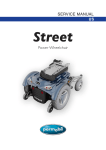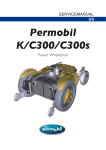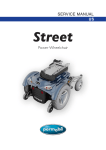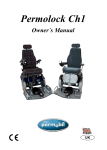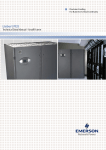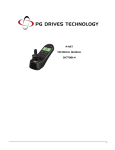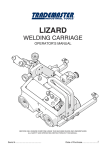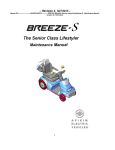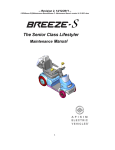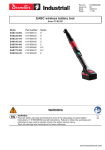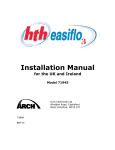Download - Permobil
Transcript
SERVICE MANUAL US Permobil C350 Power Wheelchair How to contact Permobil Head Office of the Permobil group Produced and published by Permobil AB, Sweden Version 2, 2009-08 Article no.: 205219-US-0 Contents Contents Introduction ...................................................................................................... 5 Rating plates .................................................................................................... 6 Covers ............................................................................................................... 8 Batteries ......................................................................................................... 10 Rear wheels .................................................................................................... 12 Support wheels .............................................................................................. 14 Front wheels ................................................................................................... 16 Wheel fork ...................................................................................................... 17 Shock absorbers ............................................................................................ 18 Link arms ........................................................................................................ 20 Brake release ................................................................................................. Release controls ......................................................................................... Magnetic brake ........................................................................................... Brake release switch .................................................................................. 22 22 23 24 Drive motor ..................................................................................................... 25 Electric seat lift ............................................................................................... 26 Manual seat lift operation ........................................................................... 26 Removing the seat lift ................................................................................. 27 Fixed seat tube .............................................................................................. 28 Service position .......................................................................................... 28 Adjusting the seat height ............................................................................ 28 Removing the fixed seat tube ..................................................................... 29 Seat angle mechanism .................................................................................. 30 Corpus seat ..................................................................................................... 32 PS seat............................................................................................................. 34 Control panel R-net ........................................................................................ 36 Control panel VR2 ......................................................................................... 36 Output stage R-net ......................................................................................... 37 Output stage VR2 .......................................................................................... 38 Lights module ................................................................................................ 39 ICS master module ........................................................................................ 39 Fuses .............................................................................................................. 40 Control system ............................................................................................... 41 Lights .............................................................................................................. 42 Troubleshooting guide R-net......................................................................... 44 Troubleshooting guide VR2 ........................................................................... 59 Cabling overview Rnet .................................................................................. 62 Cabling overview VR2 .................................................................................... 64 Index ............................................................................................................... 66 4 Introduction Introduction This service manual is for technical personnel who work on the maintenance and repair of Power Wheelchairs. It is important for everyone who performs maintenance and repairs as described in this manual to read and understand the contents of the manual so that the work is performed expertly. Always state the chassis number when you contact Permobil to ensure that you get the right information. Technical support For technical support, phone Permobil Försäljning och Service AB on +46 (0)60-59 59 00 or contact your local mobility aids center. Spare parts and accessories Spare parts and accessories can be ordered by phone through Permobil Parts on +46 (0)60-59 59 00. Disposal In case of doubt, contact Permobil Försäljning och Service AB for information on applicable disposal agreements. Warranty and service Permobil’s Power Wheelchairs are supplied with a three-year warranty corresponding to the purchasing agreement between the Swedish County Councils/Municipalities and Permobil. The warranty normally includes (this may vary somewhat between different County Councils) one year’s free service and then two years of product warranty (not batteries or charger). Service tasks will be started within three working days and will be carried out on site. After the warranty period, a service agreement may be entered into, guaranteeing low servicing costs and rapid assistance. Contact Permobil Svenska Försäljning och Service AB for more detailed information. Maintenance See the information in the user manual. Product approval This product meets the applicable requirements under EN 12184 and ISO 7176. 5 Rating plates Rating plates Chassis Chassis ID number Rnet output stage Rnet output stage ID number Rnet control panel Control panel Pilot+ ID number 6 Rating plates Rating plates VR2 output stage VR2 output stage ID number VR2 control panel VR2 control panel ID number VR2 lights module Control panel Pilot+ ID number 7 Covers Covers Removing the upper chassis cover The cover is fixed with two knobs (see illustration). 1. Move/fold the leg rests out and, if necessary, raise the seat. 2. Switch off the main power switch on the control panel. 3. Remove the two knobs that hold the cover in place (see illustration). 4. Remove the cover by pulling it backwards. It may be difficult to get it past the brake release control; bend the edge of the cover carefully if necessary. Assembly Assemble in the reverse order. The upper chassis cover is fixed with two knobs. Covers 8 Covers Covers Removing the front chassis cover The cover is fixed by means of Velcro on its upper/rear edges. 1. Move/fold the leg rests out. 2. Switch off the main power switch on the control panel. 3. Lift the rear edge of the cover upwards and forwards so the Velcro on the inside of the cover comes undone. Take care to ensure the cover is fitted partially inside the chassis at the front edge (see illustration). The front chassis cover is partially fitted inside the front edge of the chassis. Assembly Assemble in the reverse order. First hook the front edge of the cover firmly in the chassis, then press the upper back section of the cover so the Velcro fastening attaches to the chassis. Removing the rear chassis cover The cover is fitted with two guide lips to the upper chassis cover. 1. Switch off the main power switch on the control panel. 2. If the upper chassis cover has not been removed, loosen the knobs holding it in place and lift its rear edge to release the rear chassis cover. Raise the seat if necessary. Remove the rear chassis cover by pulling it straight backwards until the Velcro on the inside comes undone. Take care to ensure the cover is mounted partially inside the chassis at the lower edge. The rear chassis cover is fitted partially inside the chassis at the lower edge. 3. On a chassis with lights, disconnect the light cabling. Assembly Assemble in the reverse order Rear light cabling. 9 Batteries Batteries Be careful when using metal objects when working with batteries. A short-circuit can easily cause an explosion. Always use safety gloves and safety goggles. 1 Removing the front battery 1. Place the wheelchair on a level surface. 2 2. Move/fold the leg rests out and, if possible, raise the seat lift. 3. Switch off the main power switch on the control panel. Battery connections and battery brackets. 4. Remove the front chassis cover. See page 9. 5. Disconnect the battery connections (1). See the illustration. See also the sticker on the inside of the front chassis cover. 6. Remove the battery lock (2) by pulling it straight forwards (see illustration). 7. Lift/pull the battery out of the chassis using the battery belt. Lift/pull the battery out of the chassis. Assembly 1. Lift a new battery into the chassis using the battery belt. Leave the battery belt on the battery. Position the battery with the battery terminals at the front. 2. First refit the battery lock and then the battery connections to the new battery. 3. Refit the front chassis cover. See page 9. WARNING Be careful when using metal objects when working with batteries. A short-circuit can easily cause an explosion. Always use safety gloves and safety goggles. Battery removed. 10 Batteries Batteries Removing the rear battery 1. Place the wheelchair on a level surface. A 2. Switch off the main power switch on the control panel. C 3. Remove the rear chassis cover. See page 9. 4. Remove the output stage bracket by first loosening the two screws (A) and then lifting the bracket straight up while turning it upside down. Then turn the bracket to the side and place it on the left. B A. The output stage bracket is fitted using two screws. B. The cable between the chassis and the output stage bracket must not be disconnected. C. The lower section of the output stage bracket is fitted inside the rear edge of the chassis. WARNING The cable (B) that is fixed between the chassis and the output stage bracket reduces the risk of short-circuit and must not be disconnected. 5. Lift/pull the battery a little way out of the chassis and disconnect the battery connections. See also the sticker on the inside of the rear chassis cover. Be careful when using metal objects when working with batteries. A short-circuit can easily cause an explosion. Always use safety gloves and safety goggles. Lift/pull the battery a little way out of the chassis and disconnect the battery connections. 6. Lift/pull the battery out of the chassis using the battery belt. Assembly 1. Lift a new battery into the chassis using the battery belt. Leave the battery belt on the battery. Position the battery with the battery terminals at the rear. 2. Connect the battery connections on the new battery. 3. Refit the output stage bracket. Its lower section should be fitted inside the rear edge of the chassis (C). See the illustration above. Battery removed. 4. Refit the chassis covers 11 Rear wheels Rear wheels Removal 1. Switch off the main power switch on the control panel. 2. Lift up and chock up the wheelchair chassis so that the wheel in question is free of the ground. 3. Remove the hub cap by pulling it straight out. If necessary, carefully lever it out using a screwdriver in the slot on the cap. 4. Remove the four screws that hold the wheel in place. WARNING The central screw must not be removed. 5. Remove the wheel by pulling it straight out. Assembly Assemble in the reverse order. Tighten the four screws using a dynamometric wrench. Tightening torque 24 Nm. Item 1 2 3 1 Hub cap 2 Screw, ISO 4762 M8x20 8.8 Fe/Zn 5 C1 3 Rear wheels Fitting/removing rear wheels. 12 Description Rear wheels Rear wheels Taking the rim apart The rim can be taken apart to make it possible to fit/remove solid or pneumatic tires. 1. Remove the wheel in question from the wheelchair. See the previous page. 2. If the tire is pneumatic, release the air. WARNING Ensure that pneumatic tires are not pressurized before the rim is taken apart, otherwise there is a risk of personal injury. 3. Remove the six screws holding the two halves of the rim together (see illustration). 4. Take the rim apart. Assembly Assemble in the reverse order. Tighten the six screws using a dynamometric wrench. Tightening torque: 22 Nm. WARNING The recommended tire pressure for pneumatic tires is 200 kPa (2 bar). Overfilling entails a risk of explosion. Incorrect tire pressure may result in lower stability and maneuverability. Check regularly that the tires have the correct pressure. 4 3 1 Item 2 1 Rim, outer section 2 Tire 3 Rim, outer section 4 Screw, ISO 4762 M8x30 8.8 Fe/Zn 5 C1 Fitting a solid tire to a split rim. 13 Description Support wheel bracket Support wheel bracket Removal 1. Switch off the main power switch on the control panel. 2. Remove the rear wheel on the side in question. See the illustration above. 3. Remove the two screws (2) that hold the support wheel bracket in place at the rear (see illustration). At the same time, lift the support wheel carefully to make it easier to remove the screws. Please note that the spring in the top edge of the bracket now comes loose. 4. Remove the screw (1) that holds the support wheel bracket in place at the front (see illustration). 1 Assembly Assemble in the reverse order. Begin with the front screw (1) and associated spacer and washer. Then replace the spring before fitting the two remaining screws (2) with associated spacers and washers. Lift the support wheel carefully to make it easier to fit the two rear screws. 2 Attaching the support wheel 14 Support wheels Support wheels Support wheels may be fitted in three different positions: low, medium and high. These fitting positions are marked L, M and H. Low With the support wheels fitted in the lower position, low, the wheelchair inclines less before the support wheels meet the ground, but the accessibility of the wheelchair is reduced somewhat. Medium The support wheels are fitted as standard in the middle position, medium. This position suits most users. High With the support wheels fitted in the top position, high, accessibility increases somewhat, but it also means that the wheelchair may incline more before the support wheels meet the ground. Users may find this uncomfortable. Removal 1. Switch off the main power switch on the control panel. 2. Remove the screw. See the illustration. WARNING Removing the support wheels entails an increased risk of the wheelchair tipping over. The wheelchair must not be driven when the support wheels are not fitted. Assembly 1. Switch off the main power switch on the control panel. Support wheels may be fitted in three different positions: low, medium and high. 2. Fit the wheel with the screw, washer and nut in the desired position. See the illustration. 15 Front wheels Front wheels Removal 1. Switch off the main power switch on the control panel. 2. Lift up and chock up the wheelchair chassis so that the wheel in question is free of the ground. 3. Remove the hub cap 1. 4. Remove the nut 2. Apply pressure to the screw 6 using a suitable Allen key. 5. Remove the washer 3, wheel 4, axle 5 and screw 6. Assembly 1. Check that the axle and rim are not damaged. If necessary, clean to remove dirt and rust. Replaced damaged parts. 2. Fit the wheel on the axle using just your hands. Check that the wheel is fully located on the axle. 3. Fit the screw 6 in the wheel fork. 4. Fit the axle 5, wheel 4, washer 3 and nut 2, and tighten the wheel. 5. Fit the hub cap 1. Tightening torque: 33 Nm. NB Item Nuts must only be used once. Once removed, nuts must therefore never be refitted. Do not use an impact wrench for the tightening torque. WARNING No type of screw and washer other than those stated here may be used. 1 2 3 4 1 Hub cap 2 Locking nut, ISO 7040 M6 8 Fe/Zn 5 Cl 3 Washer, ISO 2768-c, 8.5x23x3 4 Front wheel 5 Axle, ISO 2768-m Ø15 6 Screw, ISO 10642, M8x70, 10.9 Fe/Zn 5 C1 5 Rim mounting. 16 Description 6 Wheel forks Wheel forks 1 Removal 1. Switch off the main power switch on the control panel. 2 2. Lift up and chock up the wheelchair chassis so that the wheel in question is free of the ground. 3. Remove the cap (1) from the top of the link arm. See the illustration. 4. Remove the wheel fork. This is held in place from above with a nut (2). See the illustration. 3 4 Assembly 5 Assemble in the reverse order. 6 Tighten the nut holding the wheel fork in place using a dynamometric wrench. Tightening torque: 33 Nm. 7 NB 8 Do not use an impact wrench for the tightening torque. Wheel fork Item 17 Description 1 Cap 2 Nut DIN 934 M14x1.5 8 Fe/Zn 8 C1 3 Link arm 4 Bearings, 6002-2RS1 (15x32x9) 5 Circlips, DIN 472 Ø32 6 Spacer, SS-EN 10277-5 - 1.6582 QT+C (SS 2541-03) 7 Wheel fork 8 Screw, ISO 2768-m Stainless Shock absorbers Shock absorbers Removing the rear shock absorber 1. Raise the seat; electric seat lift to the highest position; fixed seat tube to the service position. See page 28. If the electric seat lift does not work normally because the batteries are discharged or the adjustment device is defective, the seat can be raised/lowered manually. See page 26. 2. Switch off the main power switch on the control panel. 3. Remove the chassis covers. See page 8. 4. Lift up and chock up the wheelchair chassis so that the wheel in question is free of the ground. 5. Remove the bracket on which the output stage is fitted. See the section on changing the battery on page 11. 6. Remove the rear mounting screw of the shock absorber. See the illustration. 7. Pull the battery out far enough for the front mounting screw of the shock absorber to be accessible without any risk of short-circuit between the tool and the battery terminal. Rear mounting screw of the rear shock absorber WARNING The battery must be moved backwards far enough for there to be no risk of short-circuit between tool/chassis/battery terminal before the front mounting screw of the shock absorber is removed. 8. Remove the front mounting screw of the shock absorber. See the illustration. Fitting the rear shock absorber Front mounting screw of the rear shock absorber Fit in the reverse order. Adjust the spring force of the shock absorber before fitting. See page 19. Lubricate the bearing points (1) of the shock absorber with grease before fitting. 1 Fitting/removing the rear shock absorber 18 Shock absorbers Shock absorbers Removing the front shock absorber 1. Raise the seat; electric seat lift to the highest position; fixed seat tube to the service position. See page 28. If the electric seat lift does not work normally because the batteries are discharged or the adjustment device is defective, the seat can be raised/lowered manually. See page 26. 2. Switch off the main power switch on the control panel. 3. Remove the chassis covers. See page 8. 4. Lift up and chock up the wheelchair chassis so that the wheel in question is free of the ground. Front shock absorber mounting screws 5. Unscrew and remove the two screws that hold the shock absorber in place. See the illustration. Fitting the front shock absorber Fit in the reverse order. Adjust the spring force of the shock absorber. It is easiest to do this before fitting (see below). 1 Lubricate the bearing points (1) of the shock absorber with grease before fitting. Front shock absorber Adjusting shock absorber spring force Adjusting nut The spring force of the shock absorber must be adjusted to the correct value (see illustration). The spring force can be adjusted to suit different body weights by means of the adjusting nut. Increase the value for a softer suspension, and reduce the value for a harder suspension. If possible in practical terms, the shock absorber can be adjusted while still fitted in the chassis, but the wheelchair must be empty at the time. Adjustment Adjusting the shock absorber NB Make sure the wheelchair is empty when adjusting a previously fitted shock absorber. Body weight Never adjust to a value lower than 46 mm. 19 Adjustment 0 - 100 kg 48 mm Over 100 kg (standard) 46 mm Link arms Link arms Removing the front link arm 1. Switch off the main power switch on the control panel. 2. Lift up and chock up the wheelchair chassis so that the wheel in question is free of the ground. 3. Remove the lower shock absorber bracket. See page 19. 4. Remove the cap from the side of the link arm. See the illustration. 5. Remove the link arm. It is held in place with a screw and a washer. See the illustration. Link arm mounting For removal of wheel forks and wheels, see the respective chapters. Fitting the front link arm NB Do not use an impact wrench for the tightening torque. Fit in the reverse order. Tighten the screw holding the link arm in place with a dynamometric wrench. Item Tightening torque: 15 Nm. Description 1 Socket head cap screw ISO 4762 M8x40 8.8 Fe/Zn 5 C1 2 Washer, 8 140 HB Fe/Zn 5 C1(8.4x20x2) 3 Spacer 4 Washer, ISO 2768-m 32x8.1x3 5 Socket head cap screw ISO 7380 M8x16 10.9 Fe/Zn 5 C1 Locking Coat DIN 267-28 6 Plastic plug, Ø 38x12 (Ø32-36) 1 2 4 3 5 6 Removing/fitting the front link arm 20 Link arms Link arms Removing the rear link arm 1. Raise the seat; electric seat lift to the highest position; fixed seat tube to the service position. See page 28. If the electric seat lift does not work normally because the batteries are discharged or the adjustment device is defective, the seat can be raised/lowered manually. See page 26. 2. Switch off the main power switch on the control panel. 3. Remove the chassis covers. See page 8. 4. Lift up and chock up the wheelchair chassis so that the front and rear wheel on the side in question are free of the ground. External screws for the parallel strut. 5. Remove the front link arm. See page 20. Item 6. Remove the rear shock absorber. See page 18. Description 1 Socket head cap screw ISO 4762 M6x70 8.8 Fe/Zn 5 C1 2 Washer, ISO 7089 6 200 HV Fe/Zn 5 C1(6.4x12x1.6) 3 Spacer 4 Support wheel incl. bracket 5 Drive motor incl. gear 6 Link arm 7 O-ring, 24.2x3 EPDM Fitting the rear link arm 8 Spacer washer, 28 Fe/Zn 12 C1 (DB 28x40x1.5) Fit in the reverse order. 9 Circlip, Ø 28 mm 7. Remove the external mounting screws of the parallel strut (see illustration above). 8. Remove the link arm by pulling it straight out (see illustration below). For removal of the drive motor, see page 25. If necessary, replace the o-ring and/or circlip. Tighten the screw holding the link arms in place with a dynamometric wrench. 7 8 9 Tightening torque: 15 Nm. NB Lubricate the o-ring with grease friction brake, Item: 1820405. Do not use an impact wrench for the tightening torque. 2 1 6 5 4 3 Removal/fitting of the rear link arm and drive motor. 21 Brake release Brake release The brake release consists of a release control, a brake release switch and a magnetic brake on each drive motor. Removing the release control 1. Raise the seat; electric seat lift to the highest position; fixed seat tube to the service position. See page 28. If the electric seat lift does not work normally because the batteries are discharged or the adjustment device is defective, the seat can be raised/lowered manually. See page 26. 2. Switch off the main power switch on the control panel. 3. Remove the upper chassis cover. See page 8. Release the brakes by pressing the release control forwards and at the same time pulling it straight out. 4. Release the brakes by pressing the release control forwards and at the same time pulling it straight out (see illustration). 5. By bringing the brake release arm forwards on the right-hand magnetic brake, the release control can be pulled outwards on the left side of the chassis. Bring the brake release arm on the left-hand magnetic brake forwards in order to be able to pull the release control completely out of the chassis. Right magnetic brake release arm Fitting the release control 1. Push in the release control on the left side of the chassis. Fit the rail with the printed symbols facing upwards. 2. By bringing the brake release arms forwards on the right and left magnetic brakes, the release control can be brought into place. 3. Refit the chassis cover. See page 8. 4. Lower the seat to its normal height. NB Check the function of the break release after fitting. When the brakes are released, it should not be possible to drive the wheelchair. Brake release control 22 Brake release Brake release Removing the magnetic brake 1. Raise the seat; electric seat lift to the highest position; fixed seat tube to the service position. See page 28. If the electric seat lift does not work normally because the batteries are discharged or the adjustment device is defective, the seat can be raised/lowered manually. See page 26. 2. Switch off the main power switch on the control panel. 3. Remove the chassis cover. See page 8. 4. Divide the magnetic brake’s cabling at the contact on the cabling. This is positioned on the inside of the chassis, beside the seat lift/seat tube (see illustration). The contact on the magnetic brake cabling is positioned on the inside of the chassis, beside the seat lift/seat tube. Magnetic brake with cabling 5. Unscrew the three screws holding the brake in place (see illustration). Fitting the magnetic brake Fit in the reverse order. Fit the brake so that the brake release arm points upwards. NB Check the function of the break release after fitting. When the brakes are released, it should not be possible to drive the wheelchair. The magnetic brake is held in place with three screws. 23 Brake release Brake release Removing the brake release switch 1. Raise the seat; electric seat lift to the highest position; fixed seat tube to the service position. See page 28. If the electric seat lift does not work normally because the batteries are discharged or the adjustment device is defective, the seat can be raised/lowered manually. See page 26. 2. Switch off the main power switch on the control panel. 3. Remove the upper and front chassis cover. See page 8. Release the brakes by pressing the release control forwards and at the same time pulling it straight out. 4. Release the brakes by pressing the release control forwards and at the same time pulling it straight out (see illustration). 5. Divide the brake release switch cabling at the contact on the cabling. This is positioned on the top of the rear battery. 6. Remove the brake release switch. It is held in place with two screws. Fitting the brake release switch Fit in the reverse order. NB Check the function of the break release after fitting. When the brakes are released, it should not be possible to drive the wheelchair. The brake release switch is fitted with two screws on the left drive motor magnetic brake. 24 Drive motor Drive motor Removal 1. Raise the seat; electric seat lift to the highest position; fixed seat tube to the service position. See page 28. If the electric seat lift does not work normally because the batteries are discharged or the adjustment device is defective, the seat can be raised/lowered manually. See page 26. 2. Switch off the main power switch on the control panel. 3. Remove the chassis covers. See page 8. 4. Chock up the relevant side of the wheelchair. 5. Remove the rear wheel on the relevant side. See page 12. 6. Divide the magnetic brake and drive motor cabling at the contacts on the cabling. These are positioned on the inside of the chassis, beside the seat lift/seat tube (see illustration). 7. Run the connection cables out through the chassis’ cable duct. 8. Remove the two external screws (4) on the parallel strut. See the illustration below. 9. Remove the four screws (1) holding the drive motor’s gear and the support wheel brackets in place. See the illustration below. The contact on the magnetic brake and drive motor cabling is positioned on the inside of the chassis, beside the seat lift/seat tube. Assembly Assemble in the reverse order. Item Description 1 Socket head cap screw ISO 4762 M6x70 8.8 Fe/Zn 5 C1 2 Washer, ISO 7089 6 200 HV Fe/Zn 5 C1(6.4x12x1.6) 3 Spacer 4 Socket head cap screw, ISO 4762 M5x16 8.8 Fe/Zn 5 C1 Drive motor and magnetic brake with cabling 2 1 4 3 Drive motor and gear. 25 Electric seat lift Electric seat lift Manual raising/lowering of electric seat lift If the seat lift does not work normally because the batteries are discharged or the adjustment device is defective, the seat can be raised/lowered manually. 1. Switch off the main power switch on the control panel. 2. Remove the cushion from the seat by lifting it straight up. 3. Remove the seat plate(s). See the illustration. The seat plate for the Corpus seat is held in place with two screws. The seat plates for the PS seat are held in place with four screws. 4. Raise/lower the seat using the seat lift crank supplied. WARNING Drills must not be used in connection with manual operation of the seat lift. There is a risk of damage to materials. Manual raising/lowering of the Corpus seat using the seat lift crank 26 Electric seat lift Electric seat lift Removing the electric seat lift 1. Raise the seat to the highest position manually. See the previous page. 2. Switch off the main power switch on the control panel. 3. Remove the upper chassis cover. See page 8. 4. Remove the seat and the seat angle if the wheelchair is fitted with one. See pages 30–35. NB The seat is heavy. Two people should therefore lift it when removing or fitting it. Be careful with the cabling. The ICS general module is held in place in the chassis, to the right of the seat lift, by means of Velcro. 5. Remove the seat lift by unscrewing the four screws. See the illustration below. 6. VR2 Divide the seat lift cabling at the contact on the cabling. R-net Remove the ICS general module, which is held in place in the chassis, to the right of the seat lift, by means of Velcro. Then disconnect the seat lift cabling from the ICS general module. 7. Lift the seat lift straight up out of the chassis. Assembly Assemble in the reverse order. ICS general module The seat lift is held in place with four screws. 27 Fixed seat tube Fixed seat tube Service position The fixed seat tube can be raised to the service position to make it easier to set the fixed seat height and other service tasks on the wheelchair. 1. Loosen the screw that locks the fixed height position of the seat tube (see illustration). The seat is now pressed upwards by the integrated gas spring of the seat tube. 2. Lock the seat tube in the upper position using the screw before starting any other work (see illustration). Locking screw for the seat tube height position. WARNING Always lock the seat tube in the upper position using the screw before starting any other work. To return to normal position, undo the screw locking the seat tube height position, and push the seat downwards until the head of the height adjustment screw is in the recess in the outer tube of the seat tube (see illustration). WARNING The seat must not be subjected to load and the wheelchair must not be driven with the fixed seat tube in the service position. Make sure that the head of the height adjustment screw is in the recess in the outer tube of the seat tube after work is completed. Adjusting the seat height The length of the fixed seat tube can be adjusted to five different fixed positions. Turn the seat so that the height adjustment screw ends up in the groove in the outer tube. 1. Adjust the seat tube to the service position (see above). 2. Screw the height adjustment screw in place in the desired height position. See the illustration. The three holes in positions that raise the seat above the standard position are plugged with plastic screws. If one of these three holes is to be used, the plastic screw must first be removed. When the seat is raised above the standard position, it is recommended that the wheelchair’s control system be programmed so that the parameter for maximum forward speed is set to 75%. This particularly applies if the user’s weight exceeds 100 kg. For more information concerning programming of the control system, see page 41. WARNING Height adjustment screw in standard position. If the seat is raised above the standard position, it is recommended that the wheelchair’s control system be programmed so that the parameter for maximum forward speed is set to 75%. This particularly applies if the user’s weight exceeds 100 kg. 28 Fixed seat tube Fixed seat tube 3. Undo the screw locking the seat tube height position, and push the seat downwards. Turn the seat so that the head of the height adjustment screw is in the groove in the outer tube of the seat tube (see illustration). 4. Tighten the screw that locks the fixed height position of the seat tube. Turn the seat so that the height adjustment screw ends up in the groove in the outer tube. Removing the fixed seat tube 1. Raise the seat to the service position (see previous page). 2. Switch off the main power switch on the control panel. 3. Remove the chassis covers. See page 8. 4. Remove the seat and the seat angle if the wheelchair is fitted with one. See pages 30–35. NB The seat is heavy. Two people should therefore lift it. Be careful with the cabling. 5. Remove the seat tube by unscrewing the four screws. See the illustration. 6. Lift the seat tube straight up out of the chassis. Assembly The fixed seat tube is held in place with four screws. Assemble in the reverse order. Chassis with a fixed seat tube 29 Seat angle mechanism Seat angle mechanism Removal 1. Raise the seat; electric seat lift to the highest position; fixed seat tube to the service position. See page 28. If the electric seat lift does not work normally because the batteries are discharged or the adjustment device is defective, the seat can be raised/lowered manually. See page 26. 2. Switch off the main power switch on the control panel. 3. Remove the upper and rear chassis cover. See page 8. 4. Remove the seat. See pages 32–35. NB The seat is heavy. Two people should therefore lift it. Be careful with the cabling. 5. On a chassis with a VR2 control system, disconnect the seat angle cabling at the contact on the output stage (see illustration below). Cut the cable ties holding the cabling in place, noting the position of the cable ties for subsequent fitting. 6. Remove the seat angle by unscrewing the four screws. See the illustration. 7. Lift the seat angle away from the seat tube/seat lift. The seat angle mechanism is held in place with four screws. Assembly Assemble in the reverse order. NB Make sure that the hole on the seat angle is correctly positioned against the corresponding hole on the seat lift/seat tube. Control panel Motor 1 Left Motor 2 Right Battery Inhibit External charging socket Adjustment device Output stage cable connections (VR2). 30 Seat angle mechanism Seat angle mechanism C350 Corpus, C350 TS Seat angle mechanism fitted in hole configuration for mounting on C350 with Corpus- or TS-seat C350 PS Seat angle mechanism fitted in hole configuration for mounting on C350 with PS seat 31 Corpus seat Corpus seat Removal from chassis without seat angle 1. Raise the seat; electric seat lift to the highest position; fixed seat tube to the service position. See page 28. If the electric seat lift does not work normally because the batteries are discharged or the adjustment device is defective, the seat can be raised/lowered manually. See page 26. 2. Switch off the main power switch on the control panel. 3. Remove the cushion from the seat. The seat plate is held in place with two screws. 4. Remove the seat plate, which is held in place with two screws (see illustration). 5. Remove the control panel. See page 36. Cut off the cable ties holding the cabling in place on the seat, noting the position of the cable ties for subsequent fitting. 6. Unscrew and remove the four screws holding the seat in place. See the illustration. 7. Lift the seat off. NB The seat is heavy. Two people should therefore lift it. Be careful with the cabling. Assembly Assemble in the reverse order. The seat is held in place with four screws. Removal from chassis with seat angle 1. Remove the upper and rear chassis cover. See page 8. 2. Switch on the main power switch on the control panel. Raise the seat angle. Switch off the main power switch on the control panel. If the seat angle will not run due to discharged batteries or defective adjustment device, remove the front mounting screw of the adjustment device (see illustration). Then carefully angle the seat manually. 3. Remove the control panel. See page 36. Cut off the cable ties holding the cabling in place on the seat, noting the position of the cable ties for subsequent fitting. Front mounting screw of the adjustment device 32 Corpus seat Corpus seat 4. On chassis with VR2 . Disconnect the adjustment device cabling from the output stage. See the diagram of output stage cable connections on page 38. Cut the cable ties holding the cabling in place, noting the position of the cable ties for subsequent fitting. On chassis with Rnet . Disconnect the seat cabling from the ICS Master Module, which is fixed in the wheelchair chassis. See page 39. . Remove the seat back rest by loosening the locking pin and the two knobs on the rear of the back rest (see illustration). . Disconnect the seat angle cabling at the contacts on the general modules, which are fixed at the front of the back rest (see illustration). Loosen locking pin and knobs. 5. Remove the crush protection devices on the left and right sides, which are fixed in place with two screws each (see illustration below). 6. Remove the seat, which is held in place with two screws on the left and right sides (see illustration below). Make a note of which holes the screws are fixed in for subsequent fitting. NB The seat is heavy. Two people should therefore lift it. Be careful with the cabling. The general modules are positioned at the front of the back rest. Assembly Assemble in the reverse order. The crush protection devices on the left and right sides are held in place with two screws. The seat is held in place with two screws on the left and right sides. 33 PS seat PS seat Removal from chassis without seat angle 1. Raise the seat; electric seat lift to the highest position; fixed seat tube to the service position. See page 28. If the electric seat lift does not work normally because the batteries are discharged or the adjustment device is defective, the seat can be raised/lowered manually. See page 26. 2. Switch off the main power switch on the control panel. 3. Remove the cushion from the seat. The seat plates are held in place with four screws. 4. Remove the seat plates, which are held in place with four screws (see illustration). 5. Remove the control panel. See page 36. Cut off the cable ties holding the cabling in place on the seat, noting the position of the cable ties for subsequent fitting. 6. Unscrew and remove the four screws holding the seat in place. See the illustration. 7. Lift the seat off. NB The seat is heavy. Two people should therefore lift it. Be careful with the cabling. Assembly The seat is held in place with four screws. Assemble in the reverse order. 34 PS seat PS seat Removal from chassis with seat angle 1. Switch on the main power switch on the control panel. Raise the seat angle. Switch off the main power switch on the control panel. If the seat angle will not run due to discharged batteries or defective adjustment device, remove the front mounting screw of the adjustment device (see illustration). Then carefully angle the seat manually. 2. Remove the control panel. See page 36. Cut off the cable ties holding the cabling in place on the seat, noting the position of the cable ties for subsequent fitting. Front mounting screw of the adjustment device 3. Remove the crush protection devices on the left and right sides, which are fixed in place with two screws each (see illustration). The crush protection devices on the left and right sides are held in place with two screws. 4. Remove the seat, which is held in place with two screws on the left and right sides (see illustration). Make a note of which holes the screws are fixed in for subsequent fitting. NB The seat is heavy. Two people should therefore lift it. Be careful with the cabling. Assembly Assemble in the reverse order. The seat is held in place with two screws on the left and right sides. 35 Control panel Control panel R-net Removal 1 1. Switch off the main power switch on the control panel. 2. Remove the cable ties holding the control panel cabling in place under the arm rest. Note the positions of the cable ties for subsequent fitting. 2 3. Divide the control panel cabling at the contact on the cabling. 4. Remove the control panel (1). It is held in place with two screws (see illustration). These two screws also hold the bracket for the ICS control panel (2), if there is one fitted (see illustration). The control panel is held in place with two screws. Assembly Assemble in the reverse order. Control panel VR2 Removal 1. Remove the upper and rear chassis cover. See page 8. 2. Remove the cable ties holding the control panel cabling in place. Note the positions of the cable ties for subsequent fitting. 3. Disconnect the control panel cabling from the output stage (see illustration). The control panel cabling is connected to the output stage. 4. Remove the control panel (3). It is held in place with two screws underneath (see illustration). 3 Assembly Assemble in the reverse order. The control panel is held in place with two screws. 36 Output stage Output stage R-net Removal 1. Switch off the main power switch on the control panel. 2. Switch the main fuse to OFF. See page 40. 3. Remove the chassis covers. See page 8. 4. Disconnect the electrical connections from the output stage. Note their positions (see illustration below). Inhibit External charging socket Motor 1 Left Motor 2 Right Battery Output stage cable connections A C B The output stage is fitted with two screws. A. The output stage bracket is fitted using two screws. B. The cable between the chassis and the output stage bracket must not be disconnected. C. The lower section of the output stage bracket is fitted inside the rear edge of the chassis. 5. Remove the output stage bracket by first loosening the two screws (A) and then lifting the bracket straight up while turning it upside down. Then turn the bracket down and place it on the left. 6. Remove the output stage by unscrewing its two mounting screws. See picture above. Assembly NB The cable (B) that is fixed between the chassis and the output stage bracket must not be disconnected. Assemble in the reverse order. The lower section of the output stage bracket is fitted inside the rear edge of the chassis (C). Fit the output stage bracket with its lower section inside the rear edge of the chassis (C). See the illustration above. 37 Output stage Output stage VR2 Removal 1. 2. 3 4. Switch off the main power switch on the control panel. Switch the main fuse to OFF. See page 40. Remove the chassis covers. See page 8. Disconnect the electrical connections from the output stage. Note their positions (see illustration below). Control panel Motor 1 Left Motor 2 Right Battery Inhibit External charging socket Adjustment device Output stage cable connections (VR2). A C B The output stage is fitted with two screws. A. The output stage bracket is fitted using two screws. B. The cable between the chassis and the output stage bracket must not be disconnected. C. The lower section of the output stage bracket is fitted inside the rear edge of the chassis. 5. Remove the output stage bracket by first loosening the two screws (A) and then lifting the bracket straight up while turning it upside down. Then turn the bracket down and place it on the left. 6. Remove the output stage by unscrewing its two mounting screws. See the illustration above. Assembly NB The cable (B) that is fixed between the chassis and the output stage bracket must not be disconnected. Assemble in the reverse order. Fit the output stage bracket with its lower section inside the rear edge of the chassis (C). See the illustration above. The lower section of the output stage bracket is fitted inside the rear edge of the chassis (C). See the illustration above. 38 Lights module and ICS master module Lights module (Only applies to chassis with VR2 and lights.) Removal 1. Switch off the main power switch on the control panel. 2. Remove the chassis cover and rear battery cover. See page 8. 3. Disconnect the electrical connections from the lights module. Note their positions for subsequent fitting. 4. Remove the lights module. It is held in place with two screws. See the illustration. The lights module is held in place with two screws. Assembly Assemble in the reverse order. ICS master module (Only applies to chassis with R-net.) The wheelchair seat may be equipped with an ICS control system, and if so, the seat is controlled from the system’s ICS master module. This is fitted in the wheelchair chassis. Removal 1. Raise the seat; electric seat lift to the highest position; fixed seat tube to the service position. See page 24. If the electric seat lift does not work normally because the batteries are discharged or the adjustment device is defective, the seat can be raised/lowered manually. See page 26. 2. Switch off the main power switch on the control panel. ICS master module loose in its holder 3. Remove the chassis cover. See page 8. 4. Pull the master module straight up out of its holder (see illustration). 5. Pull the cover off. 6. Cut off the cable ties that hold the cables and detach the electrical connections. Note their positions for subsequent fitting. Assembly Assemble in the reverse order. ICS master module with cover removed 39 Fuses Fuses Resetting the main fuse The main fuse also functions as a battery isolator but it is usually called the main fuse. It is not normally necessary to replace the main fuse as it is automatic and can be reset when it has been triggered. The main fuse can be accessed through a recess in the rear chassis cover. It is reset by switching the switch to ON. See the illustration. On Off NB Main fuse/battery isolator (On/Off) If the main fuse is triggered, there is often a major electrical fault. The cause of the fault should be checked carefully before the fuse is reset. Replacing the main fuse 1. Remove the chassis covers. See page 8. 2. Switch the main fuse to OFF. See the illustration. A 3. Detach the negative cable from the rear battery. 4. Detach the positive cable from the front battery. C B NB Fold the battery connection cables under so they cannot come into contact with the battery terminals. A. The output stage bracket is fitted using two screws. B. The cable between the chassis and the output stage bracket must not be disconnected. C. The lower section of the output stage bracket is fitted inside the rear edge of the chassis. 5. Remove the output stage bracket by first loosening the two screws (A) and then lifting the bracket straight up while turning it upside down. Then turn the bracket down and place it on the left. NB The cable (B) that is fixed between the chassis and the output stage bracket must not be disconnected. 6. Remove the main fuse, which is held in place with two screws on the inside of the output stage bracket (see illustration). NB Note the direction in which the fuse is installed for subsequent fitting. The ON/OFF position must match the appropriate sticker on the chassis. Main fuse bracket 40 Fuses & control system Fuses 7. Detach the cables from the main fuse by undoing the screws (see illustration). 8. Switch the new main fuse to OFF. 9. Connect the cables to the new main fuse. NB Check that the cables are firmly attached. 10. Fit the new main fuse on the output stage bracket with the two screws. Main fuse cable connection NB Note the direction in which the fuse is installed. The ON/OFF position must match the appropriate sticker on the chassis. 11. Refit the output stage bracket. The lower section of the output stage bracket is fitted inside the rear edge of the chassis (C). See the illustration. A 12. Reattach the battery connection cables to the batteries. C 13. Reattach the chassis and seat lift cover. See page 8. B 14. Switch the main fuse to ON (see illustration). A. The output stage bracket is fitted using two screws. B. The cable between the chassis and the output stage bracket must not be disconnected. C. The lower section of the output stage bracket is fitted inside the rear edge of the chassis. Control system The wheelchair’s control system can be programmed in order to optimize the performance of the wheelchair while also maintaining a high level of safety regardless of the wheelchair’s other settings and equipment. The control system can also be programmed in order to make adjustments needed for a specific user. Standard parameter files can be downloaded from Permobil’s website, www.permobil.se. For more information on programming the VR2 control system and obtaining parameter files, see the technical user manual for programming Pilot+ / VSI / VR2 (Art.no. 205009-SE-0). For more information on programming/adjustment of the Rnet control system and obtaining parameter files, see the technical user manual for programming R-net. (Art.no. 205222-SE-0). WARNING If the seat is raised above the standard position for wheelchairs equipped with a fixed seat tube, it is recommended that the wheelchair’s control system be programmed so that the parameter for maximum forward speed is set to 75%. This particularly applies if the user’s weight exceeds 100 kg. 41 Lights Lights (accessories) Removing the front lights 1. Switch off the main power switch on the control panel. 2. Remove the front and upper chassis cover. See pages 8–9. 3. Divide the lights’ cabling at the contact on the cabling. This is loose on the inside of the chassis, over the rear battery. 4. Cut off the cable ties holding the cabling in place. Note the positions of the cable ties for subsequent fitting. The contact on the front light cabling. 5. Remove the two screws that hold each of the lights in place. These are on top of the link arm. See the illustration. Assembly Assemble in the reverse order. The front lights are fixed in place with two screws on each link arm. Adjustment of front lights 1. Loosen the lower screw on the side of the light (see illustration). 2. Adjust the angle of the light so the beam is at a suitable height. 3. Lock it at this position by retightening the screw on the side of the light. Adjusting the angle of the light 42 Lights Lights (accessories) Bulb replacement front 1. Switch off the main power switch on the control panel. 2. Unscrew and remove the two screws holding the light insert in place. Remove the insert (see illustration). 3. Remove the bulb holder by pulling it straight out, and replace the defective bulb. 4. Refit in reverse order. The light insert is held in place with two screws. Removing the rear lights 1. Switch off the main power switch on the control panel. 2. Remove the upper and rear chassis cover. See pages 8–9. 3. Disconnect the light cabling at the contact with the chassis (see illustration). Rear light cabling. 4. Remove the two screws that hold the light in place. These are on the inside of the rear chassiscover. See the illustration. Assembly Assemble in the reverse order. The rear lights are each held in place with two screws. 43 Troubleshooting Troubleshooting R-net The following troubleshooting guide describes a number of faults and events which may occur when you use your wheelchair, together with suggested remedies. Note that this guide cannot describe all the problems and events which may occur and you should always contact your service contact or Permobil in case of doubt. EVENT The wheelchair will not start. POSSIBLE CAUSE REMEDY Batteries discharged. Charge the batteries. The cable connection to the control panel has come loose. Insert the cable in the control panel. Main fuse blown. Check possible causes carefully before resetting/replacing the main fuse. See page 40. Battery charger connected. Stop charging and disconnect the charging cable from the wheelchair’s charging socket. Brake release activated. Reset the brake release. The wheelchair is locked. Unlock the wheelchair. See user manual An exclamation mark on the control panel display is flashing rapidly and the wheelchair will not run. Electronics fault. See pages 45–58. The wheelchair can only be driven at reduced speed. Seat lift raised too high. Lower seat lift. The wheelchair cannot be charged. Main fuse blown. Check possible causes carefully before resetting/replacing the main fuse. See page 40. The wheelchair cannot be driven. The wheelchair “switches The electronics’ energy-saving Switch the wheelchair on again itself off” after a certain period mode has been activated. using the start key on the control of inactivity. panel. 44 Troubleshooting Troubleshooting R-net Rnet diagnostics When an error or a fault occurs in the wheelchair’s electronics, information on it is displayed in the control panel’s display. This information can then be used to diagnose where the error/fault occurred and its cause. Troubleshooting and repairs must always be performed by competent personnel with good knowledge of the wheelchair’s electronics. More information on troubleshooting and remedies can be found in the service manual for this wheelchair model. Diagnostic screens Current diagnostic screen When the control system’s integrated protection circuits have been triggered so that the control system can no longer operate the wheelchair, a diagnostic screen is displayed in the control panel’s display. This indicates a system fault, i.e. Rnet has detected a problem somewhere in the wheelchair’s electrical system. NB! If the fault is in a module that is not currently being used, it will still be possible to drive the wheelchair, but the diagnostic screen is displayed occasionally. Switch off the wheelchair and leave it off for a few minutes. Then restart the wheelchair. If the fault persists, you must switch off the wheelchair and get in touch with your service contact. Write down the information displayed in plain text in the control panel’s display and pass it on to your service contact. Do not use the wheelchair until the problem has been remedied or you have received other instructions from your service contact. WARNING Diagnostics should only be performed by persons with sound knowledge of the wheelchair’s electronic control system. Incorrect or poorly performed repair works may make it dangerous to use the wheelchair. Permobil accepts no liability for any personal injury or damage to the wheelchair and its surroundings that occurs on account of incorrect or poorly performed repair work. 45 Troubleshooting Troubleshooting R-net Example of a screen showing a system fault Identified module Error message PM PM Low Battery Controller Fault 0506 2C00 Error code Identified module This indicates the control system module that detected the problem. PM= Power module JSM= Joystick module Error message The error message provides a brief description of the error type. Error code The four-digit code indicates which protection circuit has been triggered. 2.1.4 Example The screen example shown below displays the following information: Identified module: Power module error Error message: Low Battery Error code: 2C00 This means that the battery needs charging or that the battery has not been connected properly. • Check the battery connections. Attempt to charge the battery if it is properly connected. Identified module Error message PM Low Battery 2C00 46 Error code Troubleshooting Troubleshooting R-net 2.2 System log All errors are saved in the system log regardless of whether they have been remedied or are still active. The system log saves the error messages and the number of times they arise. The errors are saved in their respective modules within the system. The system log is accessed by means of programming directly in the system (On Board Programming, OBP). Contact Permobil or your repair engineer for more information on OBP. Go to OBP mode • Select System from the menu. • Select Diagnostics from the menu. • The diagnostics screen will now appear, showing the connected modules and version history. See the illustration below. • If a module has experienced no errors, the message No Entries will be displayed, otherwise something similar to the screenshot below will be displayed. PM 1.9 Diagnostics JSM 1.9 PM 1.9 ISM 1.9 M1 Brake Error System Error 47 6 1 Troubleshooting Troubleshooting R-net 3. Definitions of diagnostics messages When an error message has been displayed and the defective module has been identified, you can use the following definitions to determine the possible cause of the error and what remedial action is required to correct it. Error message Description Joystick Error Go to section 3.1. Low Battery Go to section 3.2. High Battery Go to section 3.3. M1 Brake Error Go to section 3.4. M2 Brake Error Go to section 3.4. M1 Motor Error Go to section 3.5. M2 Motor Error Go to section 3.5. Inhibit Active Go to section 3.6. Jstick Cal Error Go to section 3.7. Latched Timeout Go to section 3.8. Brake Lamp Short Go to section 3.9. Left Lamp Short Go to section 3.10. Right Lamp Short Go to section 3.10. L Ind Lamp Short Go to section 3.11. R Ind Lamp Short Go to section 3.11. L Ind Lamp Failed Go to section 3.12. R Ind Lamp Failed Go to section 3.12. DIME Error Go to section 3.16. Memory Error Go to section 3.17. PM Memory Error Go to section 3.18. Bad Cable Go to section 3.19. Bad Settings Go to section 3.20. Module Error Go to section 3.21. System Error Go to section 3.22. Gone to Sleep Go to section 3.23. Charging Go to section 3.24. 48 Troubleshooting Troubleshooting R-net 3.1 Joystick Error The commonest cause for this error is that the joystick was moved away from its central position before and during the time at which the control system was switched on. The screen for a shifted joystick is displayed for 5 seconds. If the joystick is not released during this time, a joystick error is registered. Even if an error screen is not displayed, the error and the number times it arises is registered in the system log. • Ensure that the joystick is in the central position and start up the control system. If the error persists, the joystick or joystick module may be defective. Read more in section 5. 3.2 Low Battery This occurs when the control system detects that the battery voltage is lower than 16 V. • Check the batteries and their connection to the control system. If the error persists after the batteries and connections have been checked, the power module may be defective. Read more in section 5. 3.3 High Battery This occurs when the control system detects that the battery voltage is higher than 35 V. The commonest causes for this error are that the battery has been overcharged or a poor connection between the control system and the batteries. • Check the batteries and their connection to the control system. If the error persists after the batteries and connections have been checked, the power module may be defective. Read more in section 5. 3.4 Brake Error This occurs when the control system detects a problem in the solenoid brakes or the connections to them. 1505 1506 - • M1 Brake Error M2 Brake Error Check the solenoid brakes, their cables and the connections to the control system. If the error persists after the checks listed above, the power module may be defective. Read more in section 5. 3.5 Motor Error This occurs when the control system detects that a motor has been disconnected. 3B00 3C00 - • M1 Motor Error M2 Motor Error Check the motors, their cables and the connections to the control system. If the error persists after the checks listed above, the power module may be defective. Read more in section 5. 3.6 Inhibit Active This occurs when one of the inhibit signals is active and is in blocked mode. The last two digits of the error code indicate the active inhibit signal. The code is hexadecimal. 1E01 1E09 1E0A - • • For inhibit signal 1. For inhibit signal 9. For inhibit signal 10. Cycle the voltage. This will deactivate the block mode, which may remedy the error. Check all connections and switches for the indicated inhibit signals. 49 Troubleshooting Troubleshooting R-net 3.7 Joystick Calibration Error This occurs when joystick calibration has been unsuccessful. • Go to OBP mode and recalibrate. If the error persists, the joystick module may be defective. Read more in section 5. 3.8 Latched Timeout This occurs when the control system detects that the programmed block time has been exceeded. This can, for example, be due to the signal units (joystick, main steering device, suction and blowing device, etc.) not having been used frequently enough. The error reference provides information on why the control system has left block mode. • • Cycle the voltage. Activate block mode. If the error persists after the checks listed above, the signal unit may be defective. Read more in section 5. 3.9 Brake Lamp Short This occurs when the control system detects a short circuit in the brake lamp electrical circuit. Read more about connectors in section 2.3. • Check the brake lamps, their cables and the connections to the control system. 3.10 Lamp Short This occurs when the control system detects a short circuit in the electrical circuit of one of the lamps. 7205 7209 - • Short circuit left-hand lamp. Short circuit right-hand lamp Check the lamps, their cables and the connections to the control system. 3.11 Indicator Lamp Short This occurs when the control system detects a short circuit in the electrical circuit of one of the indicators. 7206 720A - • Short circuit left indicator. Short circuit right indicator. Check the indicators, their cables and the connections to the control system. 3,12 Indicator Lamp Failed This occurs when the control system detects an error in the electrical circuit of one of the indicators. This usually means the indicator needs replacing. 7207 7208 - • Error in left indicator. Error in right indicator. Check the indicators, their cables and the connections to the control system. 50 Troubleshooting Troubleshooting R-net 3.16 DIME Error This occurs when the control system detects an ID conflict between two modules in the system. If a new module has been added: • • • Disconnect the new module and cycle the voltage. If no error occurs, connect the new module to the system and cycle the voltage. If the error recurs, the new module must be the cause of the problem. If no new modules have been added: • Disconnect one module at a time and cycle the voltage. If the error persists after the checks listed above have been performed, consult your service contact or Permobil. 3.17 Memory Error This is a non-specific memory error that may be caused by any of the system modules. • • Check all cables and connections. Cycle the voltage. If the error persists and the system includes third-party modules: • Disconnect all modules that do not come from PGDT and cycle the voltage. If this has dealt with the error: • Connect one third-party module at a time and cycle the voltage each time. • If the error recurs after one of the voltage cycles, the last module to be connected must be defective. If the error persists after the checks listed above, the power module may be defective. Read more in section 5. 3.18 PM Memory Error This is a specific error in the power module. • • Check all cables and connections. Reprogram the control system with the help of R-net’s PC programmers. This should be done with either the latest specific program file for the wheelchair or Permobil’s original program file. If the error persists after the checks listed above, the power unit may be defective. Read more in section 5. NB Programming should only be performed by persons with sound knowledge of control systems from PGDT. Incorrect programming can mean that the wheelchair is not safe to use. Permobil cannot be held responsible for losses of any kind if the control system factory settings are altered by programming. 51 Troubleshooting Troubleshooting R-net 3.19 Bad Cable This occurs when the control system detects a connection error in the communication cables between the modules. • • • Check all cables and connections to ensure there is no stoppage. Replace any cables with visible damage. Then cycle the voltage. Disconnect one cable at a time from the system and cycle the voltage after each disconnection. If the error persists after the checks listed above, the power unit may be defective. Read more in section 5. 3.20 Bad Settings This occurs when the control system detects incorrect or invalid program settings. • • • Check all parameter settings and then reprogram the control system with the help of R-net’s PC programmers. Make a note of the current parameter settings and then reset the control system to the standard settings. Reprogram the required settings in small groups and cycle the voltage after each group to see if the error recurs. If the error persists after the checks listed above, the power unit may be defective. Read more in section 5. 3.21 Module Error This occurs when the control system detects an error in a specific module. The module is displayed on the diagnostics screen according to the description in section 2. • • Check all cables and connections. Cycle the voltage. If the error persists after the checks listed above, the module specified may be defective. Read more in section 5. 52 Troubleshooting Troubleshooting R-net 3.22 System Error This occurs when the control system detects an error that cannot be ascribed to a specific module. • • Check all cables and connections. Cycle the voltage. If the error persists and the system includes third-party modules: • Disconnect all modules that do not come from PGDT and cycle the voltage. If this has dealt with the error: • Connect one third-party module at a time and cycle the voltage each time. • If the error recurs after one of the voltage cycles, the last module to be connected must be defective. If the error persists after the checks listed above, the system from PGDT may be defective. Read more in section 5. 3.23 Gone to Sleep (energy saving mode) This occurs when the system has not been used for a period that exceeds the Sleep Timer parameter used for setting the energy saving mode. Each time this occurs it is registered in the system log. 3.24 Charging This occurs when the control system detects that a charger has been connected to either inhibit contact 1 or inhibit contact 3. Read more about connectors in section 2.3. The screen for battery charging is displayed when a charger is connected. Each time this occurs it is registered in the system log. When using an integral charger: • Disconnect the charger from the mains. When using an external charger: • Disconnect the charger from the power wheelchair. If the error persists after the charger has been disconnected, the joystick module may be defective. Read more in section 5. 53 Troubleshooting Troubleshooting R-net 4. Basic test After a repair has been completed, the following test should be performed. These are minimum recommendations. Depending on what the original error source was, further tests may be necessary. WARNING The tests described are minimum recommendations. It is the responsibility of the repair engineer(s) to perform other tests on the basis of the original error source and the wheelchair model. The necessary information on other tests is available in the wheelchair service manual. Permobil cannot be held responsible for losses of any kind that may arise when these tests are conducted, or that arise as a consequence of further relevant tests not being conducted. WARNING These tests should be conducted in an open space, and some kind of clamping device, such as a safety belt, should always be used. Permobil cannot be held responsible for losses for any kind arising due to these recommendations not being observed. 4.1 Basic inspection Check that all contacts are properly connected. • • • • Check all cables and contacts to ensure there is no visible damage. Check that the rubber gaiter around the base of the joystick is not damaged. Inspect the gaiter visually. It should not be subjected to manual handling. Ensure that all components of the control system are securely installed. Do not over-tighten the mounting screws. 54 Troubleshooting Troubleshooting R-net 4.2 Brake test These tests should be carried out on an even surface with at least one meter of free space around the wheelchair. • • • Switch on the control system. Check that the screen remains on after start-up. Bring the joystick slowly forwards until you hear the parking brakes functioning. In some cases the wheelchair may begin to move. Release the joystick immediately. You must hear both parking brakes functioning within 2 seconds. Repeat the test three times, bringing the joystick slowly backwards, to the left and to the right. • • 4.3 Test run Set the highest permitted speed to the lowest value and run the wheelchair in all directions while checking that it runs smoothly and is easy to maneuver. Repeat the test with the speed control set to the highest possible value. 4.4 Gradient test WARNING When this test is conducted, an additional person must be present in order to prevent the wheelchair tipping over backwards. Run the wheelchair forwards up its steepest permitted gradient. Release the joystick when the wheelchair is on the upward slope and check that the wheelchair stops and that the brakes function as they should without the front wheels lifting from the ground. Bring the joystick forwards and continue to run up the slope. Check that the wheelchair moves gently forwards. Stop the wheelchair and reverse down the slope. Release the joystick when the wheelchair is on the upward slope and check that the wheelchair stops and that the brakes function as they should without the front wheels lifting from the ground. 55 Troubleshooting Troubleshooting R-net 4.5 Test of lights, indicators and warning lights If the wheelchair is equipped with lights: • • • Check that all bulbs light up as they should. Check that all bulbs light up as they should and that the flashing frequency is 1.5 Hz ± 0.5 Hz. Remove the bulbs in turn and check that the remaining bulb on the same side flashes at a requency of 3 Hz ± 0.5 Hz. If the wheelchair is equipped with warning lights: • Check that all bulbs light up as they should and that the flashing frequency is 1.5 Hz ± 0.5 Hz. 4.6 Test of adjustment device If the wheelchair is equipped with an adjustment device: • • Check that all motors move in the right direction. Make sure that the mechanical end stops are secured and that they stop the adjustment device motors, and thus use the automatic end stop tracking that is in the seat and light module (ISM). 4.7 Test of inhibit signal Connect a suitable battery charger or equivalent inhibit connecting device in the charging contact on the joystick module and check that the wheelchair is prevented from running. If inhibit contacts 2, 3, 4 and 5 are used for inhibiting or speed restriction, an appropriate test should be performed in order to check that they are functioning as they should. 5. Repairing defective units Apart from specific OEM-approved spare parts (contact Permobil for further information on these), there are no replaceable parts in the Rnet control system. Consequently, defective units must be sent to Permobil or a Permobil-approved repairer for repair. NB If any part is replaced without Permobil’s approval, the control system’s warranty lapses. NB Permobil cannot be held responsible for losses of any kind arising as a result of a component of the Rnet control system being opened, adjusted or modified without permission. 56 Troubleshooting Troubleshooting R-net Rnet diagnostics When an error or a fault occurs in the wheelchair’s electronics, information on it is displayed in the control panel’s display. This information can then be used to diagnose where the error/fault occurred and its cause. Troubleshooting and repairs must always be performed by competent personnel with good knowledge of the wheelchair’s electronics. More information on troubleshooting and remedies can be found in the service manual for this wheelchair model. Diagnostic screens Current diagnostic screen When the control system’s integrated protection circuits have been triggered so that the control system can no longer operate the wheelchair, a diagnostic screen is displayed in the control panel’s display. This indicates a system fault, i.e. Rnet has detected a problem somewhere in the wheelchair’s electrical system. NB! If the fault is in a module that is not currently being used, it may still be possible to drive the wheelchair, but the diagnostic screen is displayed occasionally. Switch off the wheelchair and leave it off for a few minutes. Then restart the wheelchair. If the fault persists, you must switch off the wheelchair and get in touch with your service contact. Write down the information displayed in plain text in the control panel’s display and pass it on to your service contact. Do not use the wheelchair until the problem has been remedied or you have received other instructions from your service contact. WARNING Diagnostics should only be performed by persons with sound knowledge of the wheelchair’s electronic control system. Incorrect or poorly performed repair works may make it dangerous to use the wheelchair. Permobil cannot be held responsible for any personal injury or damage to the wheelchair and its surroundings that occurs on account of incorrect or poorly performed repair work. 57 Troubleshooting Troubleshooting R-net Example of a screen showing a system fault Identified module Error message PM PM Low Battery Controller Fault 0506 2C00 Error code Identified module This indicates the control system module that detected the problem. PM= Power module JSM= Joystick module Error message The error message provides a brief description of the error type. Error code The four-digit code indicates which protection circuit has been triggered. Repair of defective units Apart from specific OEM-approved spare parts (contact Permobil for further information on these), there are no replaceable parts in the Rnet control system. Consequently, defective units must be sent to Permobil or a Permobil-approved repairer for repair. NB If any part is replaced without Permobil’s approval, the wheelchair’s warranty lapses. Permobil cannot be held responsible for losses of any kind arising as a result of a component of the Rnet control system being opened, adjusted or modified without permission. 58 Troubleshooting Troubleshooting VR2 The following troubleshooting guide describes a number of faults and events which may occur when you use your wheelchair, together with suggested remedies. Note that this guide cannot describe all the problems and events which may occur and you should always contact your service contact or Permobil in case of doubt. EVENT The wheelchair will not start. POSSIBLE CAUSE REMEDY Batteries discharged. Charge the batteries. The cable connection to the control panel has come loose. Insert the cable in the control panel. Main fuse blown. Check possible causes carefully before resetting/replacing the main fuse. See page 40. Battery charger connected. Stop charging and disconnect the charging cable from the wheelchair’s charging socket. Brake release activated. Reset the brake release. The wheelchair is locked. Unlock the wheelchair. See user manual. The battery voltage indicator on the control panel is flashing rapidly and the wheelchair will not run. Electronics fault. See pages 60–61. The wheelchair stops while being driven. The cable connection to the control panel has come loose Insert the cable in the control panel. The wheelchair can only be driven at reduced speed. Seat lift raised too high. Lower seat lift. The wheelchair cannot be charged. Main fuse blown. Check possible causes carefully before resetting/replacing the charging fuse. See page 40. The wheelchair cannot be driven. The wheelchair “switches The electronics’ energy-saving Switch the wheelchair on again itself off” after a certain period mode has been activated. using the start key on the control of inactivity. panel. 59 Troubleshooting Troubleshooting VR2 VR2 electronics diagnostics Battery voltage indicator Each time the wheelchair is started, parts of the wheelchair’s electronics are checked. If any fault has occurred in these parts, this is displayed on the control panel’s battery voltage indicator and the indicator for speed/driving profile in the form of one or more flashing lamps. Troubleshooting and repairs must always be performed by competent personnel with good knowledge of the wheelchair’s electronics. More information on troubleshooting and remedies can be found in the service manual for this wheelchair model. Permanently on Everything is in order. The number of lamps that light up depends on the voltage remaining in the batteries. If the batteries are fully charged, all the lamps light up. Slowly flashing red lamps, 1 - 2 The batteries need to be charged immediately. Flashing fast, 1 - 10 lamps A fault has been detected in the wheelchair’s electronics and the wheelchair cannot be driven. • • Switch off the wheelchair. Check that all visible cables and the cable to the control panel are connected correctly. Switch the wheelchair on again. If the fault persists, count the number of flashing lamps and check for a possible cause and remedy in the table on the adjoining page. Do not use the wheelchair until the problem has been remedied or you have received other instructions from your service contact. WARNING Diagnostics should only be performed by persons with sound knowledge of the wheelchair’s electronic control system. Incorrect or poorly performed repair works may make it dangerous to use the wheelchair. Permobil cannot be held responsible for any personal injury or damage to the wheelchair and its surroundings that occurs on account of incorrect or poorly performed repair work. NB Any error signals on the indicators are not displayed while the wheelchair is being driven. They appear when it is next started. 60 Troubleshooting Troubleshooting VR2 ERROR SIGNAL ERROR INDICATION - REMEDY 1 Lamp - Low battery voltage Check the condition of the battery. Check the contact between the battery and the control unit. 2 Lamps - Failure in left drive motor Check the connection to the left drive motor. 3 Lamps - Short-circuit in left drive motor Check the drive motor’s contacts and cables. 4 Lamps - Failure in right drive motor Check the connection to the right drive motor. 5 Lamps - Short-circuit in right drive motor Check the drive motor’s contacts and cables. 6 Lamps - Battery charger connected Disconnect the battery charger. 7 Lamps - Joystick error Check that the joystick has not been moved when the wheelchair is started 8 Lamps - Control system error Check the contacts to the output stage. 9 Lamps - Failure in brake circuit Check the contacts to the magnetic brake. 10 Lamps - High battery voltage Check the battery and the contacts between the battery and the control unit. 7+5 Lamps - Communication error A communication error has been indicated. Check that the cable to the control panel is not damaged and is correctly inserted. 8+2 Lamps - Adjustment device error An adjustment device error has been indicated. If the wheelchair is fitted with more than one adjustment device, check which one is not working. Check the adjustment device cable connections. 61 Cabling overview 1 2 3 A B C D E F 62 4 Cabling overview 5 6 7 8 A B C D E F Cabling overview R-net 63 Cabling overview 1 2 3 A B C D E F 64 4 Cabling overview 5 6 7 8 A B C D E F Cabling overview VR2 65 Index Index B M Batteries ............................................ 10 Brake release .................................... 22 Maintenance ........................................ 5 O C Output stage Rnet ............................ 37 Output stage VR2 ............................ 38 Cabling overview Rnet .................... 62 Cabling overview VR2 ...................... 64 Contents .............................................. 4 Control panel R-net .......................... 36 Control panel VR2 ............................ 36 Control system ................................ 41 Corpus seat........................................ 32 Covers ................................................ 8 P PS seat................................................ 34 R Rating plates ...................................... 6 Rear wheels ...................................... 12 D Drive motor ...................................... 25 S E Electric seat lift .................................. 26 Seat angle mechanism .................... 30 Shock absorbers .............................. 18 Support wheels ................................ 14 F T Fixed seat tube ................................ 28 Front wheels .................................... 16 Fuses ................................................ 40 Technical support .............................. 5 Troubleshooting guide Rnet ............ 44 Troubleshooting guide VR2 ............ 59 I W Wheel fork ........................................ 17 ICS master module .......................... 39 Introduction ........................................ 5 L Lights ................................................ 42 Lights module .................................. 39 Link arms............................................ 20 66 67 Article no.: 205219-US-0




































































